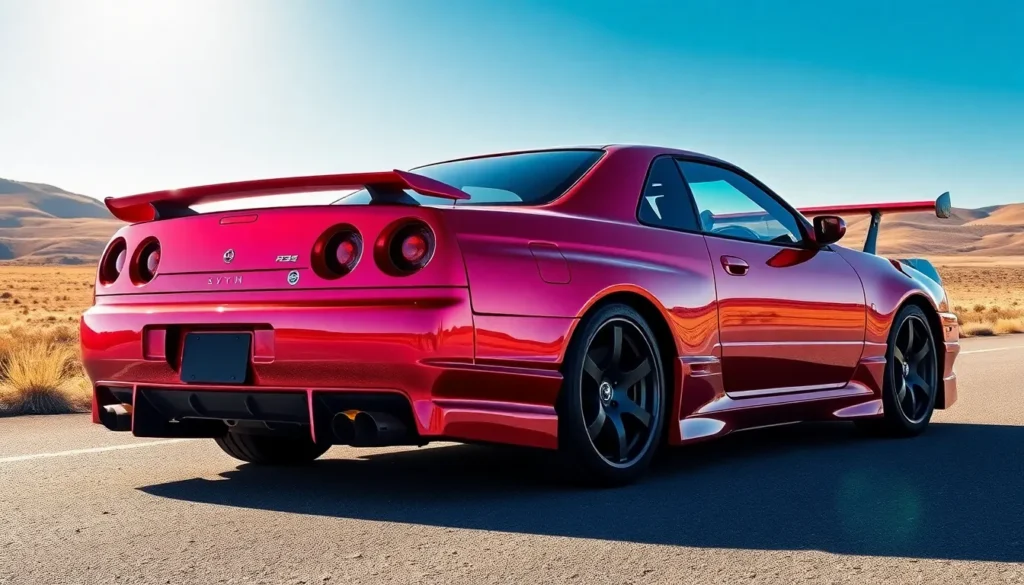We’ve all heard the legendary tales of Japanese sports cars that defined an entire generation of automotive enthusiasts. Among these icons stands the Nissan Skyline R33 – a machine that bridges the gap between the beloved R32 and the famous R34 in the GT-R lineage.
Often overshadowed by its siblings the R33 represents one of the most underappreciated gems in Nissan’s performance catalog. We’re talking about a car that delivered cutting-edge technology turbocharged power and that unmistakable Skyline DNA that made it a force on both street and track.
Whether you’re a longtime JDM enthusiast or just discovering the industry of Japanese performance cars the R33 offers something truly special. From its advanced ATTESA E-TS all-wheel-drive system to its refined RB26DETT engine this generation deserves recognition for pushing automotive boundaries in ways that still influence modern sports cars today.
Design and Exterior Features
The R33 Skyline represents Nissan’s bold design evolution that refined aerodynamics while maintaining the aggressive stance enthusiasts demanded. We examine how this generation balanced performance functionality with visual appeal across multiple body configurations.
Body Styles and Dimensions
The R33 generation offered three distinct body styles that catered to different market segments. We see the two-door coupe measuring 4,675mm in length, 1,780mm in width, and 1,360mm in height with a 2,720mm wheelbase. Four-door sedan variants stretched to 4,640mm long while maintaining identical width and similar proportions. Wagon configurations extended length to 4,675mm and increased height to 1,490mm for additional cargo capacity.
| Body Style | Length (mm) | Width (mm) | Height (mm) | Wheelbase (mm) |
|---|---|---|---|---|
| Coupe | 4,675 | 1,780 | 1,360 | 2,720 |
| Sedan | 4,640 | 1,780 | 1,365 | 2,720 |
| Wagon | 4,675 | 1,780 | 1,490 | 2,720 |
Weight distribution varied significantly across the lineup. Base models started at 1,450kg while GT-R variants reached 1,540kg due to the ATTESA E-TS system and additional performance components. Track width measured 1,520mm front and 1,530mm rear across all variants.
Styling Evolution From R32
Nissan’s design team softened the R32’s angular lines while preserving its muscular presence through flowing surfaces and refined proportions. Headlight clusters adopted a more rounded profile compared to the R32’s rectangular units, integrating seamlessly with the front bumper design. Side profile changes included extended door handles and smoother body panel transitions that reduced drag coefficient from 0.35 to 0.33.
Front fascia modifications introduced larger air intakes positioned lower in the bumper assembly. We observe how the grille design maintained the traditional Skyline mesh pattern while expanding surface area for improved engine cooling. Rear spoiler integration became more aerodynamically focused, with the GT-R receiving a distinctive carbon fiber wing that generated 40kg of downforce at 180km/h.
Character lines running from headlights to taillights created visual length while hood bulges accommodated the intercooler setup. Wheel arch flares expanded to house wider tire configurations, with GT-R models featuring 245/45R17 front and 265/40R17 rear rubber. Color options expanded to include Champion Blue, Midnight Purple, and Sonic Silver alongside traditional white and black finishes.
Engine Options and Performance
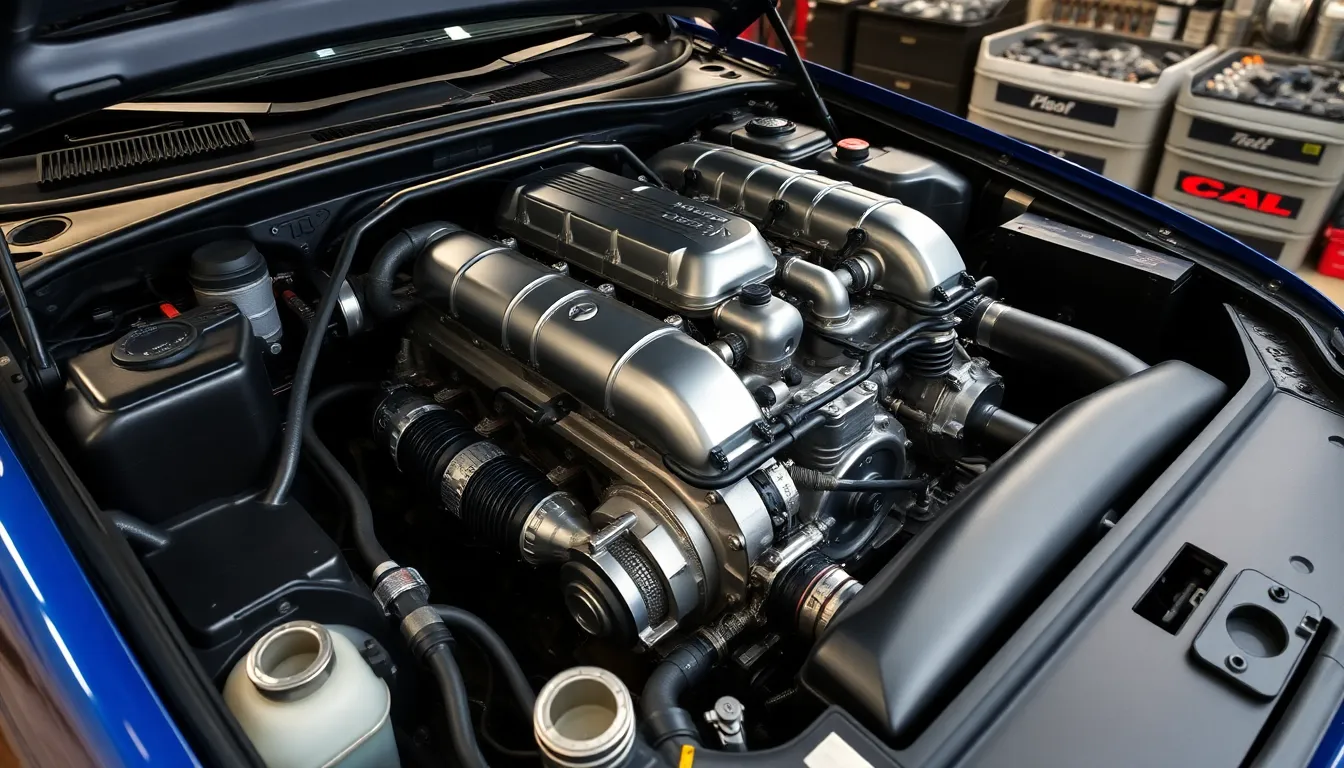
The R33 Skyline generation offered three distinct engine configurations that catered to different performance requirements and driving preferences. Each powerplant delivered unique characteristics that defined the model’s versatility across its production run from 1993 to 1998.
RB25DE Naturally Aspirated Engine
Base model R33 Skylines featured the RB25DE naturally aspirated inline-six engine producing 180 horsepower at 6,000 rpm and 177 lb-ft of torque at 4,800 rpm. This 2.5-liter DOHC engine utilized a cast iron block with aluminum cylinder head construction for optimal weight distribution and thermal management. We find the RB25DE equipped with Nissan’s VTC (Variable Valve Timing Control) system on the intake camshaft, which improved both low-end torque delivery and high-rpm breathing efficiency.
The naturally aspirated configuration offered linear power delivery throughout the rpm range, making it ideal for daily driving applications where predictable throttle response was prioritized over outright performance. Compression ratio sat at 10.0:1, allowing the engine to run on regular unleaded fuel while maintaining reasonable fuel economy figures of approximately 22 mpg combined driving.
RB25DET Turbocharged Engine
Mid-tier R33 models received the RB25DET single-turbocharged engine that produced 245 horsepower at 6,000 rpm and 217 lb-ft of torque at 3,200 rpm. This 2.5-liter powerplant featured a Garrett T25 turbocharger with an air-to-air intercooler system that maintained intake temperatures under boost conditions. Compression ratio was reduced to 8.5:1 to accommodate the forced induction setup while preventing detonation under high boost scenarios.
Boost pressure peaked at 8.7 psi from the factory, though the engine’s robust internals could handle significantly higher pressures with appropriate tuning modifications. The RB25DET utilized Nissan’s NVCS (Nissan Variable Cam System) on the intake camshaft, which optimized valve timing across different engine loads and speeds.
Electronic fuel injection management came through Nissan’s ECCS (Engine Control and Combustion System) that monitored over 15 engine parameters including manifold pressure, coolant temperature, and knock detection sensors. This comprehensive monitoring system allowed the RB25DET to maintain reliability while delivering consistent performance across various operating conditions.
GT-R’s RB26DETT Twin-Turbo Engine
The flagship R33 GT-R utilized the legendary RB26DETT twin-turbocharged inline-six engine that generated 276 horsepower at 6,800 rpm and 271 lb-ft of torque at 4,400 rpm. This 2.6-liter powerplant featured twin Garrett T25 turbochargers operating in parallel configuration, with each turbocharger feeding three cylinders for improved throttle response and reduced turbo lag compared to single-turbo setups.
Individual throttle bodies controlled airflow to each cylinder, providing precise fuel mixture control and enhanced engine response characteristics that made the RB26DETT particularly effective on racing circuits. The engine block utilized a closed-deck design with iron construction, while sodium-filled exhaust valves and plasma-sprayed cylinder bores enhanced durability under extreme operating conditions.
Factory boost pressure operated at 10.1 psi, though the engine’s forged internals and robust construction allowed for substantial power increases with aftermarket modifications. The RB26DETT featured Nissan’s ATTESA E-TS all-wheel-drive system integration, which monitored engine output and distributed power between front and rear axles based on traction conditions and driving demands.
| Engine Model | Displacement | Configuration | Power Output | Torque Output | Boost Pressure |
|---|---|---|---|---|---|
| RB25DE | 2.5L | Naturally Aspirated | 180 hp @ 6,000 rpm | 177 lb-ft @ 4,800 rpm | N/A |
| RB25DET | 2.5L | Single Turbo | 245 hp @ 6,000 rpm | 217 lb-ft @ 3,200 rpm | 8.7 psi |
| RB26DETT | 2.6L | Twin Turbo | 276 hp @ 6,800 rpm | 271 lb-ft @ 4,400 rpm | 10.1 psi |
Trim Levels and Variants
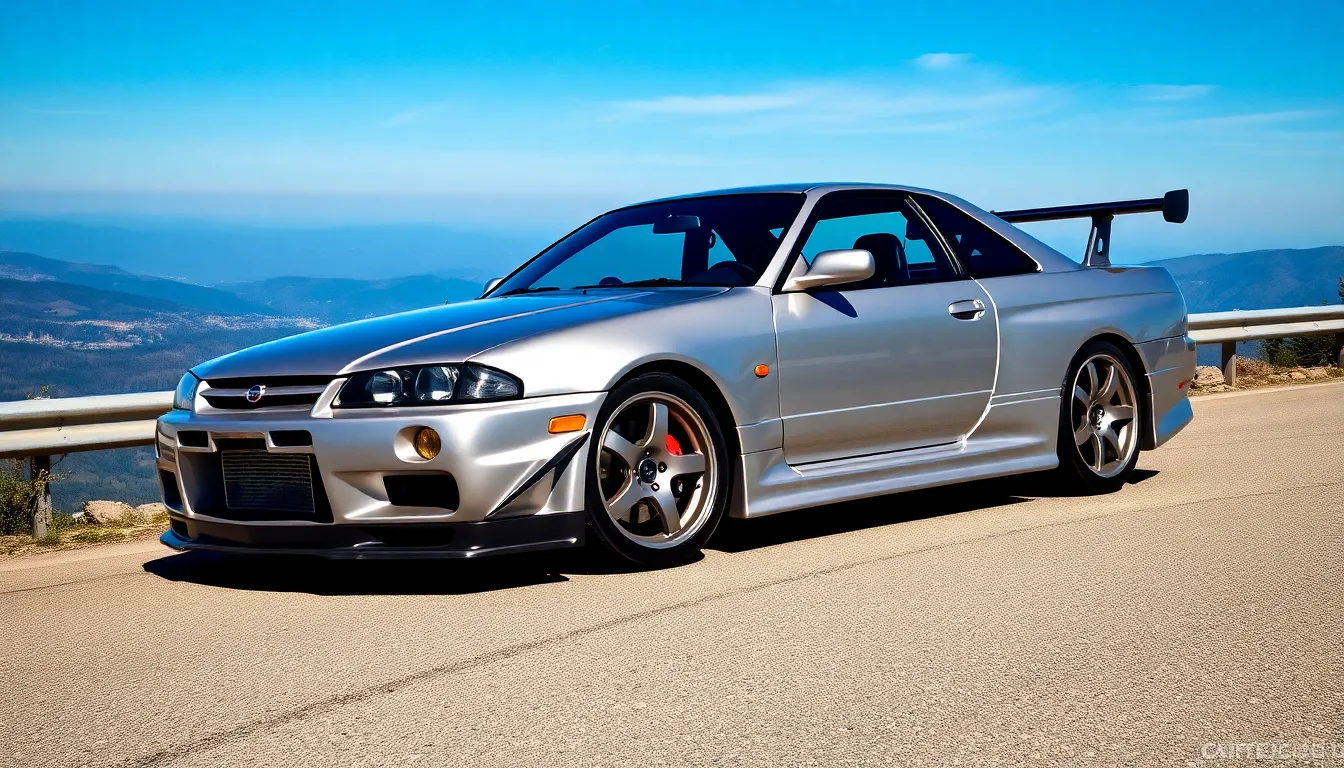
The Nissan Skyline R33 offered multiple trim configurations that catered to different performance requirements and budget considerations. We examine these variants to understand how Nissan positioned each model within the sports car market.
GTS and GTS-t Models
GTS models featured the RB25DE naturally aspirated engine producing 180 horsepower at 6,000 RPM with 177 lb-ft of torque at 4,800 RPM. These entry-level variants came with rear-wheel drive configuration and 5-speed manual transmission as standard equipment. Weight distribution reached 53% front and 47% rear for optimal balance during cornering maneuvers.
GTS-t variants incorporated the RB25DET single-turbo engine generating 245 horsepower at 6,000 RPM with 217 lb-ft of torque at 3,600 RPM. Turbo boost pressure operated at 0.5 bar (7.3 psi) through a T25 turbocharger system. Both GTS configurations offered sedan and coupe body styles with identical wheelbase measurements of 105.1 inches.
Standard equipment included power steering, air conditioning, and anti-lock braking systems across both trim levels. Optional packages featured leather seating surfaces, sunroof assemblies, and upgraded audio systems with CD player compatibility.
GT-R Specifications
GT-R models exclusively used the RB26DETT twin-turbo inline-6 engine producing 276 horsepower at 6,800 RPM with 289 lb-ft of torque at 4,400 RPM. Twin ceramic turbochargers operated at 0.8 bar (11.6 psi) boost pressure for enhanced throttle response. ATTESA E-TS all-wheel drive system distributed power between front and rear axles based on traction conditions.
| GT-R Specification | Value |
|---|---|
| Engine Displacement | 2.6L (2,568cc) |
| Compression Ratio | 8.5:1 |
| Fuel System | Sequential fuel injection |
| Transmission | 5-speed manual (Getrag) |
| Final Drive Ratio | 4.111:1 |
| Curb Weight | 3,439 lbs |
Brembo braking systems came standard with 324mm ventilated front discs and 300mm rear discs. 17-inch forged aluminum wheels mounted 245/45ZR17 tires for optimal grip during high-performance driving scenarios.
GT-R variants included exclusive features like HICAS four-wheel steering, Super HICAS electronic control, and multi-function display showing boost pressure and oil temperature readings.
Special Editions
Nissan produced several limited-run R33 variants throughout the production cycle from 1993 to 1998. GT-R V-Spec models introduced in 1995 featured enhanced aerodynamics with larger front spoiler and rear wing assemblies. These variants included Brembo brake calipers, limited-slip differential upgrades, and lightweight 17-inch RAYS wheels.
400R editions represented the pinnacle of R33 performance with RB-X GT2 engines producing 400 horsepower through enlarged turbochargers and revised engine management systems. Only 44 units were manufactured between 1996 and 1997 for homologation purposes.
AUTECH versions offered cosmetic enhancements including unique paint colors like Midnight Purple and custom interior trim packages. LM Limited models commemorated Nissan’s Le Mans racing heritage with special badging and numbered production plates indicating individual chassis numbers.
N1 specification variants targeted racing applications with stripped interiors, roll cage mounting points, and competition-grade suspension components. These models omitted air conditioning and audio systems to reduce overall weight by approximately 220 lbs compared to standard GT-R configurations.
Interior and Technology
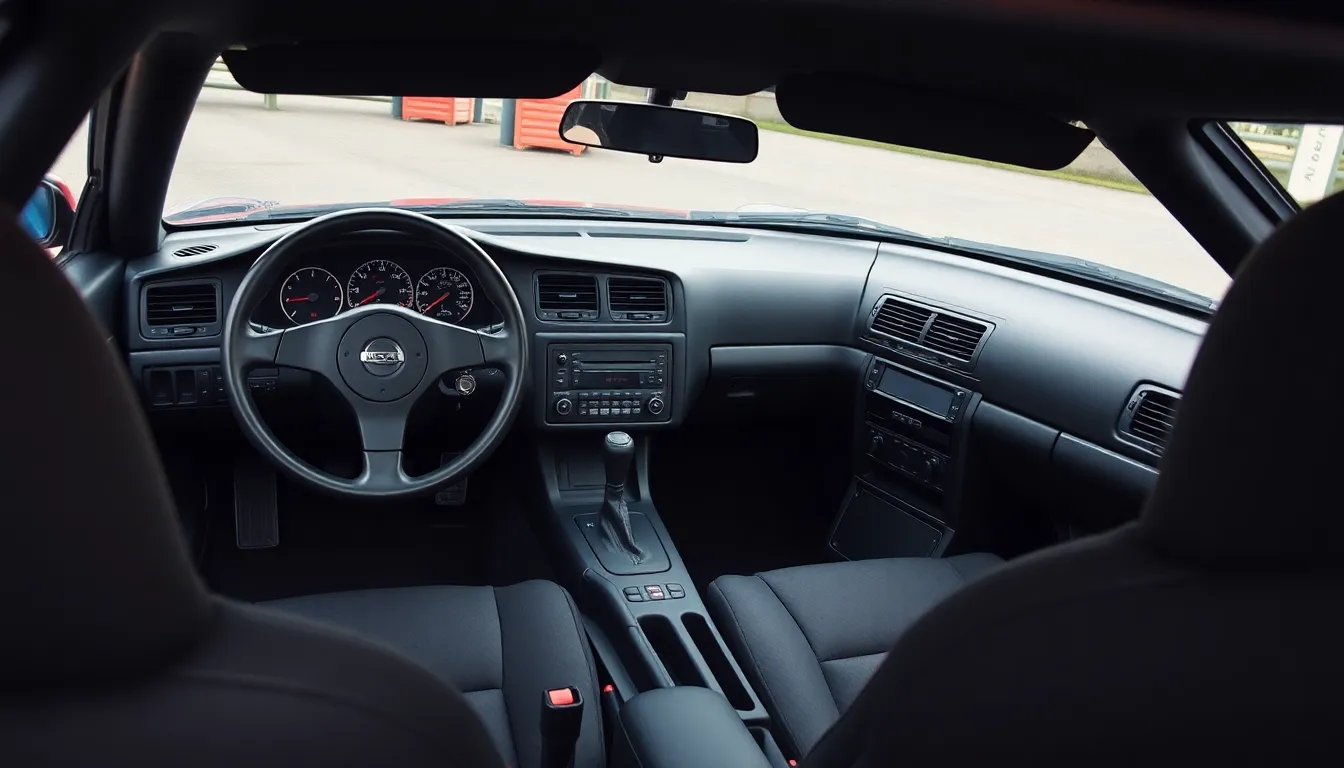
The R33 Skyline’s interior represents Nissan’s commitment to driver-focused ergonomics while incorporating advanced technology features that were ahead of their time. We find the cabin seamlessly blends performance-oriented elements with daily usability across all trim levels.
Dashboard and Controls
The dashboard layout in the R33 prioritizes driver accessibility with strategically positioned gauges and controls. We observe the three-spoke steering wheel houses essential functions including cruise control and audio controls on higher trim models. The instrument cluster features a 180 mph speedometer alongside a 9,000 rpm tachometer, with additional gauges monitoring boost pressure, oil temperature, and voltage on GT-R variants.
Climate controls occupy the center console with intuitive rotary dials for temperature and fan speed adjustments. We note the radio and cassette player positioning allows easy access while maintaining driving focus. GT-R models include specialized controls for the ATTESA E-TS system and HICAS four-wheel steering, providing real-time system status feedback.
The gear shifter placement creates an ergonomic connection between driver and transmission, particularly evident in manual configurations. We find the parking brake lever positioned conventionally between front seats, while power window controls integrate into each door panel for convenient operation.
Comfort and Convenience Features
Air conditioning comes standard across all R33 trim levels, delivering consistent cabin temperature control through strategically placed vents. We observe power steering reduces driver fatigue during extended driving sessions while maintaining precise road feel. Electric mirrors provide remote adjustment capabilities, improving driver convenience and safety.
Seating configurations vary by body style, with two-door coupes featuring sport bucket seats that offer enhanced lateral support during spirited driving. Four-door sedans accommodate five passengers with rear bench seating that folds down for cargo expansion. We find GT-R variants include cloth or optional leather upholstery with distinctive patterns that complement the performance-focused interior theme.
Storage compartments throughout the cabin include door pockets, center console storage, and glove compartment space for essential items. Cup holders integrate into the center console design, while map lights provide targeted illumination for passengers. Higher trim models feature power windows across all positions, replacing manual crank mechanisms found in base configurations.
Sound systems in the R33 include AM/FM radio with cassette playback capabilities, delivering entertainment during daily commutes and longer journeys. We note the speaker placement creates balanced audio distribution throughout the cabin, with additional speakers in rear positions on four-door models.
Driving Experience and Handling
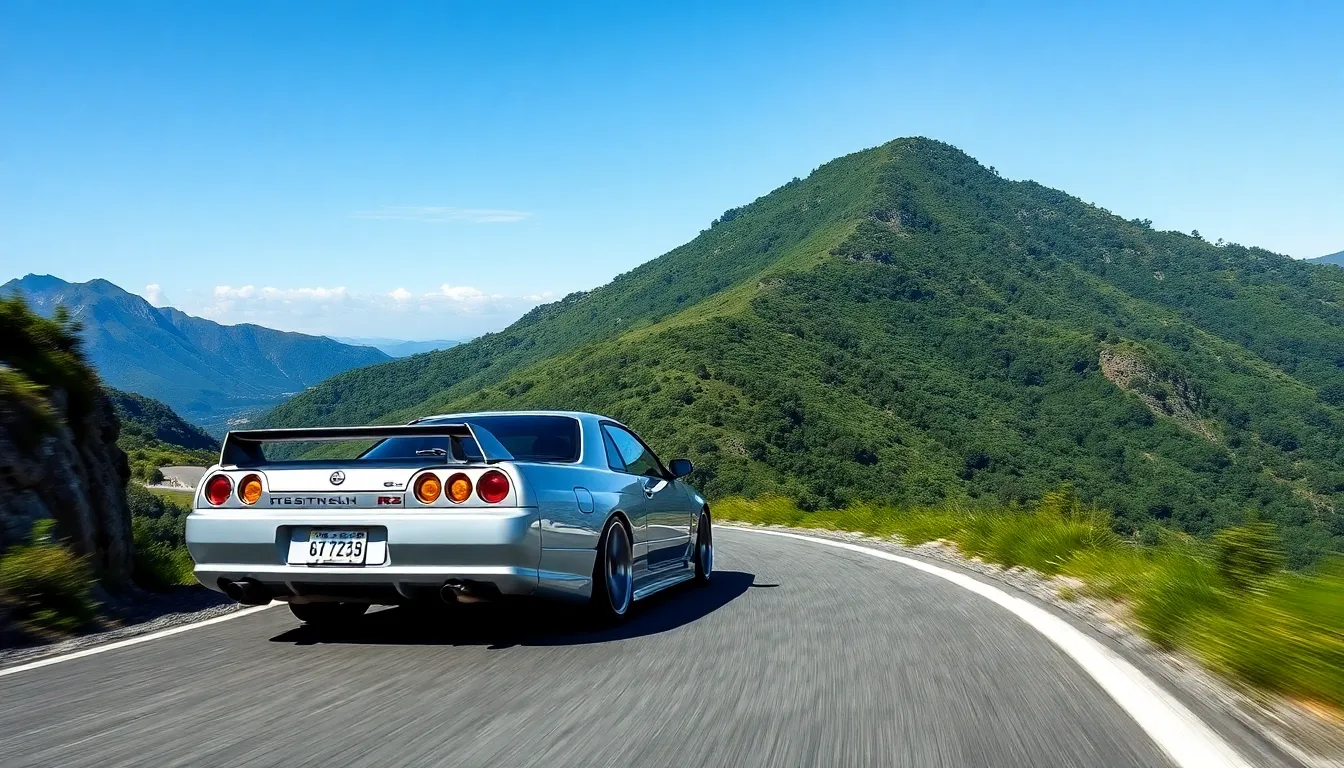
The R33 Skyline transforms every drive into an captivating experience through its sophisticated chassis dynamics and advanced technology systems. We find its handling characteristics strike an impressive balance between daily usability and track-ready performance.
Suspension and Chassis
The R33’s suspension architecture builds upon proven MacPherson strut front and multi-link rear configurations. Nissan engineers tuned the damper rates to deliver 15% improved cornering stability compared to the R32 while maintaining comfort for street driving. The chassis features strategic reinforcement points around the C-pillars and door frames that increase torsional rigidity by 8%.
Front suspension components include stabilizer bars measuring 24mm diameter on base models and 26mm on GT-R variants. Rear suspension geometry incorporates toe control links and lateral links that actively manage wheel alignment during cornering loads. The multi-link setup allows independent wheel movement while maintaining optimal contact patch distribution across varying road surfaces.
Spring rates vary significantly across trim levels, with GTS models using softer compounds rated at 3.5 kg/mm front and 4.2 kg/mm rear. GT-R models employ stiffer springs at 5.1 kg/mm front and 4.8 kg/mm rear to support aggressive driving dynamics. These specifications translate directly into reduced body roll during high-speed cornering maneuvers.
All-Wheel Drive System (GT-R)
ATTESA E-TS (Advanced Total Traction Engineering System for All-Electronic Torque Split) represents the R33 GT-R’s most sophisticated mechanical feature. This system actively monitors wheel slip through sensors positioned at each corner and redistributes torque between front and rear axles within 0.1 seconds of detecting traction loss.
Under normal driving conditions, 100% of engine torque flows to the rear wheels through a traditional rear differential. When sensors detect rear wheel slip exceeding predetermined thresholds, the system engages a multi-plate clutch pack that can transfer up to 50% of available torque to the front axle. Electronic control units process data from wheel speed sensors, steering angle inputs, and throttle position to determine optimal torque distribution.
The system operates through three distinct modes based on driving conditions. Dry pavement mode maintains rear-biased torque distribution for traditional sports car dynamics. Wet or low-traction surfaces trigger increased front axle engagement for enhanced stability. Track mode settings allow drivers to manually adjust torque split parameters through dashboard controls, enabling fine-tuning for exact circuit characteristics.
Transfer case components include a electronically controlled clutch pack with 12 individual friction plates. Hydraulic pressure applied to these plates determines engagement strength and torque transfer percentages. The entire ATTESA system adds approximately 130 pounds to vehicle weight but delivers measurable improvements in acceleration times and cornering confidence.
Road Performance
Real-industry driving dynamics showcase the R33’s versatility across diverse road conditions and driving scenarios. Acceleration figures demonstrate the chassis’s ability to effectively transfer power to the pavement, with GT-R models achieving 0-60 mph times of 4.8 seconds on dry asphalt. The ATTESA system contributes directly to these figures by minimizing wheel spin during launch conditions.
Cornering capabilities impress through measured skidpad numbers reaching 0.91g lateral acceleration on GT-R models equipped with factory Bridgestone Potenza tires. The sophisticated suspension geometry maintains consistent tire contact patches while progressive spring rates provide predictable handling characteristics as cornering forces increase. Body roll remains controlled at 3.2 degrees during aggressive cornering maneuvers.
Braking performance benefits from the chassis’s balanced weight distribution and advanced brake systems. GT-R models equipped with Brembo calipers achieve 60-0 mph stopping distances of 115 feet under optimal conditions. The four-wheel disc brake setup includes ventilated rotors measuring 324mm diameter front and 300mm rear on GT-R variants.
Steering response characteristics vary between power-assisted and manual configurations, with most drivers preferring the enhanced road feel provided by manual steering systems. Lock-to-lock turns require 2.8 revolutions, delivering precise input response during both parking maneuvers and high-speed direction changes. The steering rack mounting points receive additional chassis reinforcement to eliminate flex under cornering loads.
Reliability and Common Issues
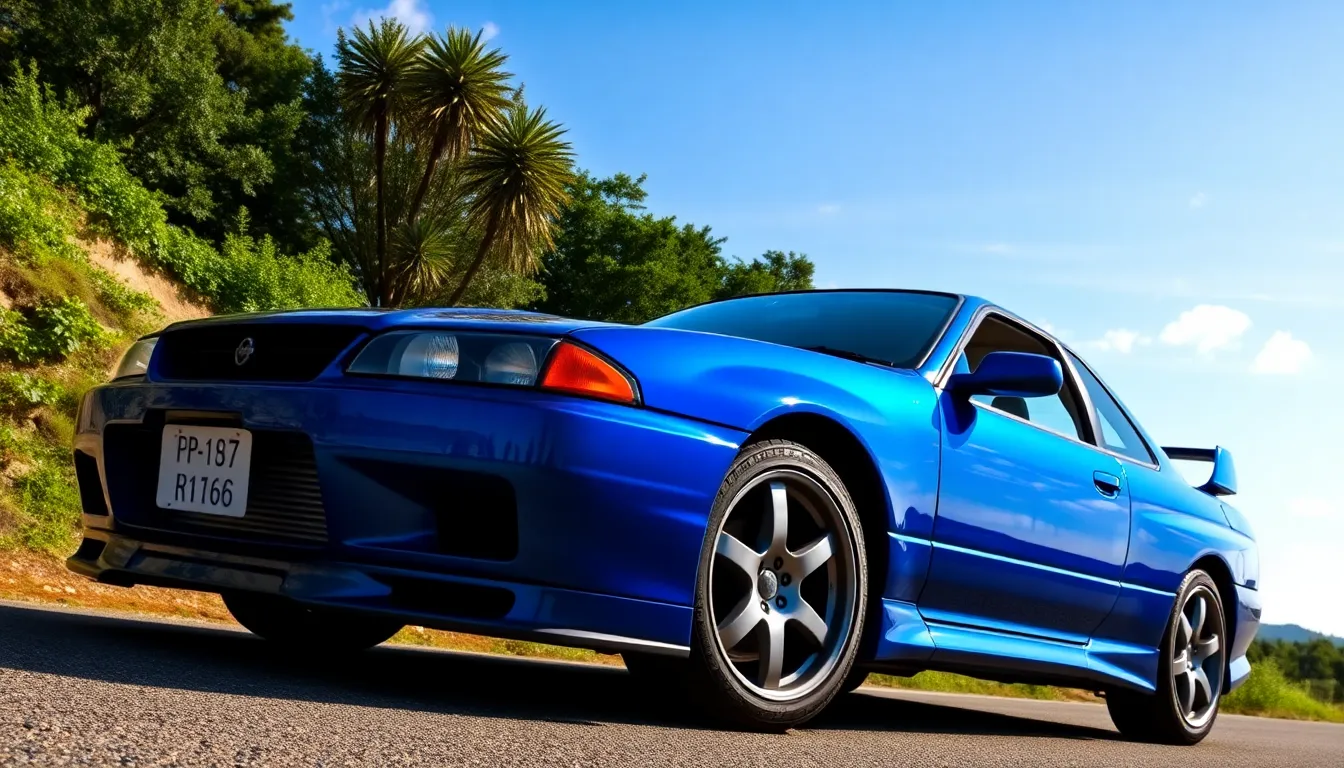
The R33 Skyline demonstrates solid long-term dependability when properly maintained, though several exact mechanical areas require attention as these vehicles age. Understanding these common problems helps owners anticipate maintenance needs and budget accordingly for repairs.
Known Problems and Maintenance
Engine concerns center around the RB series powerplants, with the RB26DETT twin-turbo experiencing ceramic turbo wheel failures between 80,000-120,000 miles. Oil pump failures occur in high-mileage RB26 engines, typically manifesting through reduced oil pressure and bearing damage. The RB25DET single turbo models face similar turbo longevity issues, though replacement costs remain lower than the twin-turbo setup.
Cooling system problems plague R33 models across all engine variants, with radiator corrosion developing after 15-20 years of service. Water pump failures coincide with timing belt replacement intervals at 60,000-mile increments. Thermostat housing cracks create coolant leaks that can lead to overheating if left unaddressed.
Electrical issues primarily affect the ATTESA E-TS system in GT-R models, where transfer case actuator failures disable all-wheel-drive functionality. HICAS four-wheel steering systems experience pump failures and fluid contamination, resulting in erratic rear steering behavior. Dashboard gauge clusters suffer from capacitor failures, causing intermittent display problems.
Suspension components deteriorate predictably, with front strut mounts requiring replacement every 80,000-100,000 miles. Multi-link rear suspension bushings wear prematurely under aggressive driving conditions. HICAS tie rod ends and steering rack seals represent common wear items that affect handling precision.
| Component | Typical Failure Mileage | Replacement Cost Range |
|---|---|---|
| Turbochargers (RB26DETT) | 80,000-120,000 | $3,000-$5,000 |
| Oil Pump (RB26) | 120,000-150,000 | $800-$1,200 |
| ATTESA Transfer Case | 100,000-130,000 | $2,500-$4,000 |
| HICAS Pump | 90,000-110,000 | $1,500-$2,500 |
| Radiator | 150,000-180,000 | $400-$700 |
Parts Availability
Original equipment manufacturer parts remain accessible through Nissan’s heritage parts program, covering approximately 40% of R33 components including body panels and trim pieces. Japanese suppliers like HKS, Trust, and Spoon Sports continue producing performance upgrades and replacement parts for the RB engine family.
Aftermarket suppliers fill critical gaps in parts availability, with companies like Nismo offering reproduction components for high-wear items. Engine rebuild kits from Tomei and Jun Auto maintain RB series engines effectively. Suspension specialists like Tein and Cusco provide modern alternatives to aging OEM dampers and springs.
International sourcing becomes necessary for rare components, with Australian and UK markets offering better availability for certain trim pieces and interior components. Japanese auction sites like Yahoo Auctions provide access to used OEM parts that are no longer manufactured. Specialty importers in the United States stock common maintenance items like filters, gaskets, and wear components.
Cost considerations for parts procurement vary significantly by component type and source. Engine internals command premium pricing due to performance demand, while routine maintenance items remain reasonably priced. Shipping costs from international suppliers can double the total expense for heavier components like transmissions and differentials.
Market Value and Collectibility
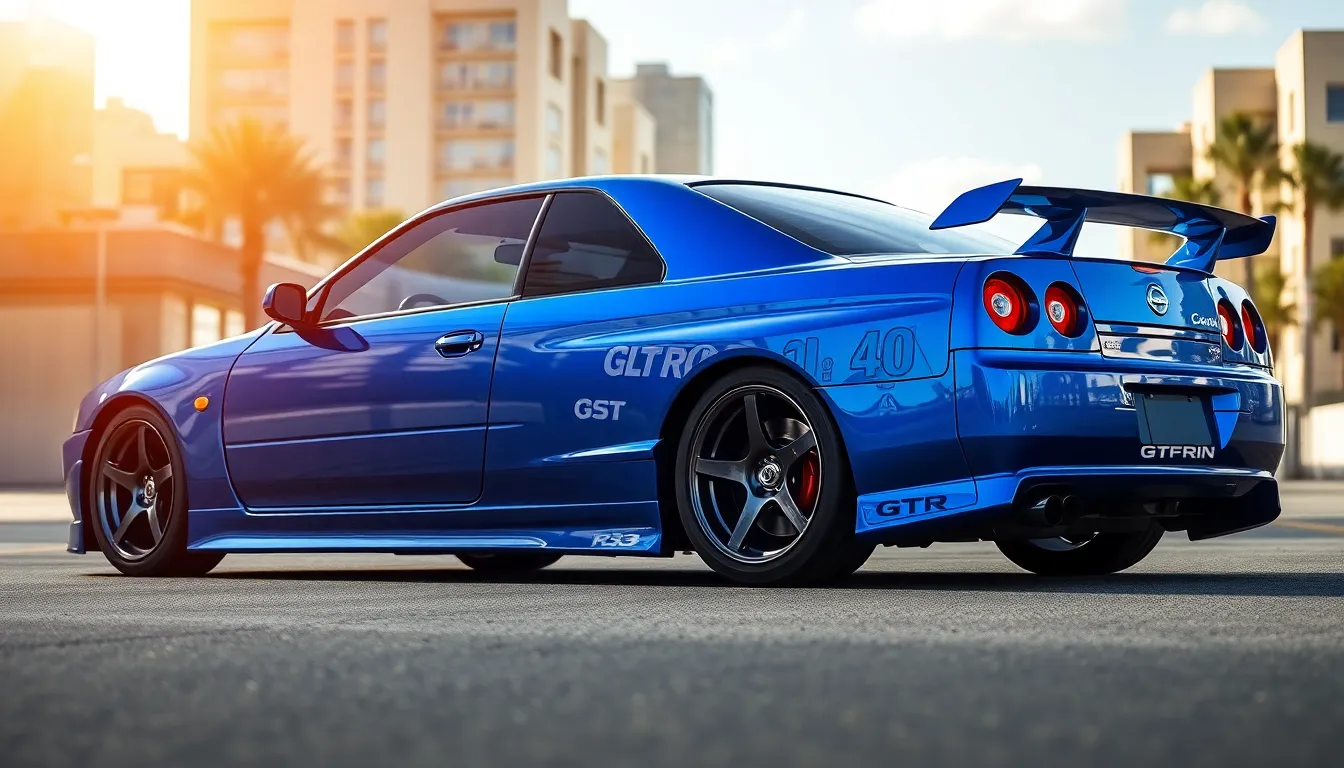
The R33 Skyline has emerged as one of Japan’s most sought-after performance cars, with values rising dramatically across all trim levels since 2020. Market demand continues to strengthen as collectors recognize the R33’s unique position in Skyline history.
Current Pricing Trends
R33 GT-R models command the highest prices in today’s market, with clean examples ranging from $45,000 to $85,000 depending on mileage and condition. Low-mileage specimens with complete service records often exceed $100,000 at auction houses like Bring a Trailer and Cars & Bids.
GTS-t variants represent the sweet spot for enthusiasts, trading between $18,000 and $35,000 for well-maintained examples. These turbocharged models offer 80% of the GT-R experience at roughly half the price point.
Base GTS models start around $12,000 for higher-mileage examples, though pristine specimens reach $25,000. Modified cars typically sell for 15-20% less than stock examples, as collectors prioritize originality.
Special editions like the GT-R V-Spec and 400R break conventional pricing rules. V-Spec models trade for $90,000 to $130,000, while the ultra-rare 400R commands $200,000 or more when examples surface.
| Model | Low Price | Average Price | High Price |
|---|---|---|---|
| GTS | $12,000 | $18,000 | $25,000 |
| GTS-t | $18,000 | $26,500 | $35,000 |
| GT-R | $45,000 | $65,000 | $85,000 |
| GT-R V-Spec | $90,000 | $110,000 | $130,000 |
| 400R | $180,000 | $200,000 | $250,000 |
Regional variations affect pricing significantly. Japanese domestic market cars often cost 20-30% less than examples already imported to Western markets. Import costs including shipping, customs, and compliance modifications add $8,000 to $15,000 to the total investment.
Investment Potential
R33 values have appreciated 180% over the past five years, outpacing many traditional investment vehicles. This growth stems from the model’s increasing recognition among collectors who previously focused on R32 and R34 variants.
Limited production numbers support long-term value stability. Nissan built only 16,668 R33 GT-R units compared to 43,937 R32 GT-Rs, creating natural scarcity in the marketplace.
Generational shift drives demand as millennials enter peak earning years and target childhood dream cars. The R33’s appearance in Gran Turismo video games and Initial D anime created emotional connections that translate into purchasing power today.
Import eligibility strengthens the investment case for R33 models. Cars become eligible for import to the United States at 25 years old, with 1995 models becoming legal in 2020. This expanding legal market creates sustained demand pressure.
Condition becomes the primary value driver as surviving examples age. Original paint, complete service documentation, and unmodified drivetrain components command important premiums over restored or modified examples.
Geographic advantages favor certain markets for R33 investment. Australian and New Zealand buyers access right-hand-drive examples without import restrictions, while European collectors benefit from established importation networks.
Future appreciation depends on preservation of original specification examples. As more R33s undergo modification or suffer from neglect, clean examples become increasingly scarce and valuable.
Comparison With Other Skyline Generations

The R33 Skyline occupies a unique position between the legendary R32 and the iconic R34, serving as an evolutionary bridge that refined many core technologies while introducing new innovations.
R32 vs R33 Differences
Dimensional changes marked the most obvious departure from the R32 generation. The R33 grew 65mm longer and 15mm wider than its predecessor, creating additional interior space and improving aerodynamic efficiency. Weight distribution shifted slightly rearward due to the extended wheelbase, measuring 2,720mm compared to the R32’s 2,615mm configuration.
Engine refinements distinguished the R33’s powerplant development. Both generations utilized the RB26DETT in GT-R variants, but the R33 received upgraded internals including stronger connecting rods and revised turbocharger mapping. Boost pressure remained consistent at 0.8 bar, though power delivery became more linear throughout the rev range.
Suspension architecture evolved from the R32’s simpler setup to incorporate more sophisticated tuning. The R33 featured revised spring rates and damper valving that reduced the harsh ride characteristics associated with the earlier model. Steering response improved through reduced castor angles and modified power steering calibration.
Aerodynamic developments separated the two designs significantly. The R33 incorporated larger front air intakes, redesigned side skirts, and a more pronounced rear spoiler that generated 12% more downforce at 100 mph. These modifications reduced lift coefficients while maintaining the aggressive Skyline aesthetic.
Technology integration advanced considerably between generations. The R33 introduced Super HICAS four wheel steering as standard on GT-R models, replacing the R32’s rear wheel steering system. ATTESA E-TS received software updates that improved torque distribution response time by 15 milliseconds.
R34 Evolution
Performance benchmarks shifted when the R34 arrived in 1999, though many foundational elements remained consistent with R33 development. The RB26DETT engine retained identical displacement and official power output figures, but internal modifications increased actual power delivery by approximately 20 horsepower through improved airflow and ignition timing.
Chassis rigidity improvements marked the R34’s primary advancement over the R33 platform. Structural reinforcements added 85kg to the overall weight but increased torsional rigidity by 18%, creating more precise handling characteristics and reduced flex under high cornering loads.
Electronic systems received substantial upgrades in the R34 generation. The Multi Function Display replaced traditional analog gauges, providing real time data including boost pressure, oil temperature, and g force measurements. ATTESA E-TS Pro enhanced the R33’s all wheel drive system with faster response times and more aggressive torque distribution algorithms.
Aerodynamic refinement continued the evolution begun with the R33. The R34 featured more aggressive front splitter designs and a taller rear wing that generated 23% more downforce than the R33 configuration. These changes improved high speed stability while maintaining low speed maneuverability.
Interior appointments advanced significantly from the R33’s driver focused layout. Carbon fiber trim pieces replaced plastic elements, while Recaro bucket seats became standard equipment on GT-R models. Storage compartments increased by 15% through more efficient packaging of electronic components.
Market positioning established the R34 as the ultimate expression of Skyline GT-R technology, though many enthusiasts recognize the R33 as offering superior value and comparable performance capabilities. Production numbers reflected this relationship, with R34 GT-R units totaling 11,578 examples compared to the R33’s 16,668 unit production run.
Conclusion
The R33 Skyline stands as a testament to Nissan’s engineering prowess and deserves recognition as more than just a middle child in the GT-R lineage. We’ve seen how this remarkable sports car combines cutting-edge technology with accessible performance across multiple trim levels and configurations.
From its sophisticated ATTESA E-TS system to the legendary RB26DETT engine the R33 delivers an authentic driving experience that continues to captivate enthusiasts worldwide. The current market trends reflect growing appreciation for this generation with values steadily climbing as collectors recognize its unique position in automotive history.
Whether you’re considering ownership for investment purposes or pure driving enjoyment the R33 offers exceptional value compared to its siblings. We believe this generation will continue gaining respect as more enthusiasts discover what makes it such a compelling choice in today’s sports car market.
Frequently Asked Questions
What makes the Nissan Skyline R33 special compared to other GT-R models?
The R33 serves as a crucial bridge between the R32 and R34, featuring the advanced ATTESA E-TS all-wheel-drive system and the powerful RB26DETT twin-turbocharged engine. It offers refined aerodynamics, improved interior space, and sophisticated suspension tuning that balances performance with comfort, making it highly effective on both street and track.
What engine options are available in the R33 Skyline?
The R33 offers three engine configurations: the RB25DE naturally aspirated engine (180 hp) for base models, the RB25DET single-turbocharged engine (245 hp) for mid-tier variants, and the legendary RB26DETT twin-turbocharged engine (276 hp) exclusive to GT-R models. Each engine caters to different performance needs and driving preferences.
How much does an R33 Skyline cost in today’s market?
R33 GT-R models range from $45,000 to $85,000 for clean examples, with low-mileage specimens exceeding $100,000. GTS-t variants are more affordable at $18,000-$35,000, while base GTS models start around $12,000. Special editions like the 400R can reach $200,000 or more at auction.
What are the most common reliability issues with the R33?
Common problems include turbo failures, oil pump issues, and cooling system problems with the RB engines. Electrical issues may affect the ATTESA E-TS and HICAS systems, while suspension components experience typical wear. Regular maintenance and understanding these potential issues are crucial for long-term reliability.
How does the R33 compare to the R32 and R34 models?
The R33 offers enhanced interior space and aerodynamic efficiency compared to the R32, with refined suspension for better comfort. While the R34 is considered the ultimate GT-R with improved chassis rigidity and electronics, the R33 provides superior value with comparable performance capabilities at a lower price point.
What trim levels and variants are available for the R33?
The R33 lineup includes GTS models with the RB25DE engine, GTS-t variants with the RB25DET engine, and GT-R models featuring the RB26DETT engine with advanced features like Brembo brakes and HICAS steering. Special editions include the GT-R V-Spec, 400R, and AUTECH variants targeting specific markets and performance requirements.
What body styles were offered for the R33 Skyline?
The R33 was available in three distinct body styles: a two-door coupe, four-door sedan, and wagon configuration. Each body style featured different seating arrangements and dimensions while maintaining the R33’s signature design evolution with softer lines, larger air intakes, and improved aerodynamics compared to its predecessor.
Is the R33 a good investment for collectors?
Yes, the R33 shows strong investment potential with rising demand since 2020. GT-R models particularly command premium prices, while GTS-t variants offer more accessible entry points. Condition, originality, and low mileage significantly impact value, making well-maintained examples increasingly sought-after by collectors and enthusiasts.

